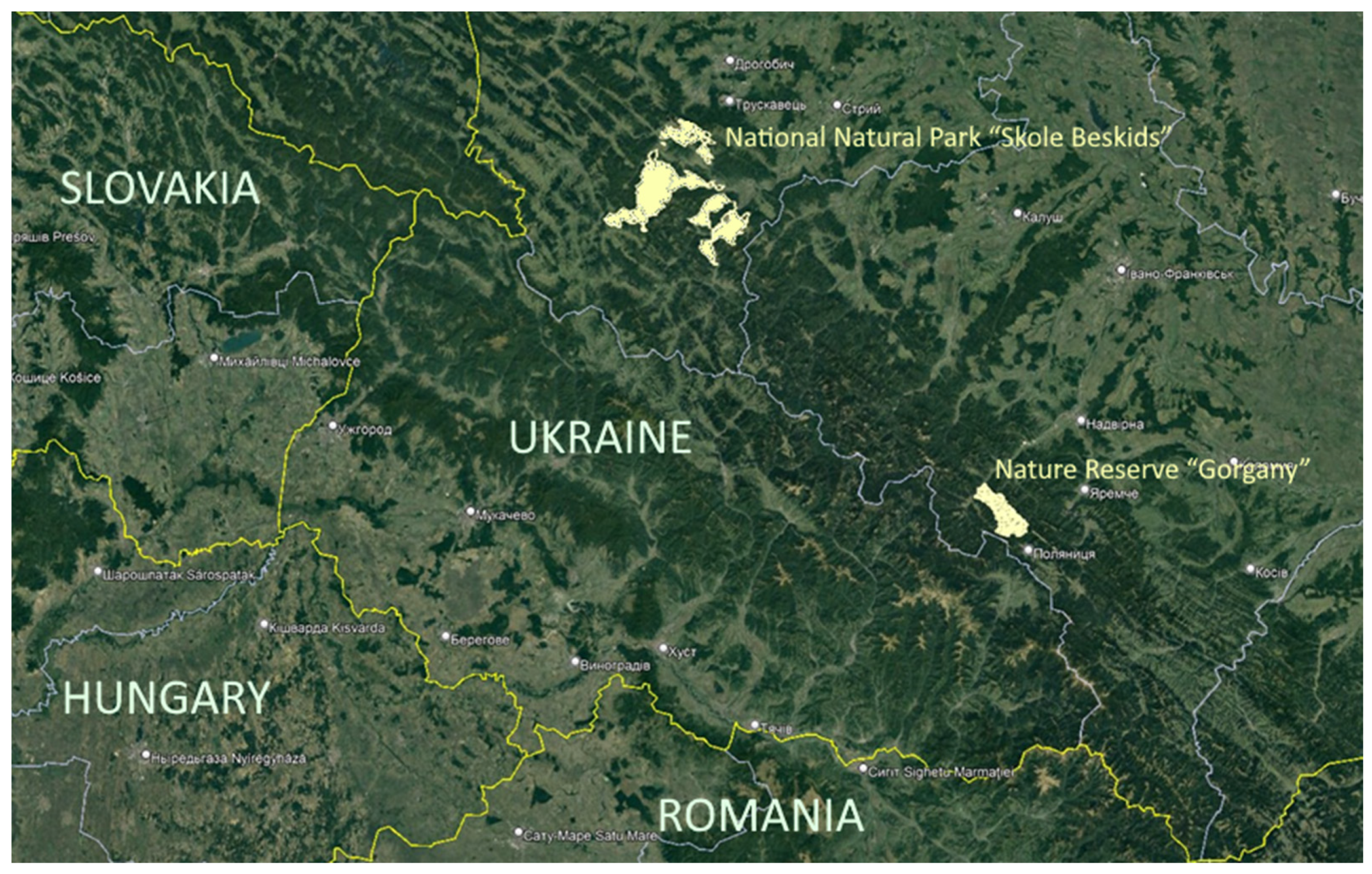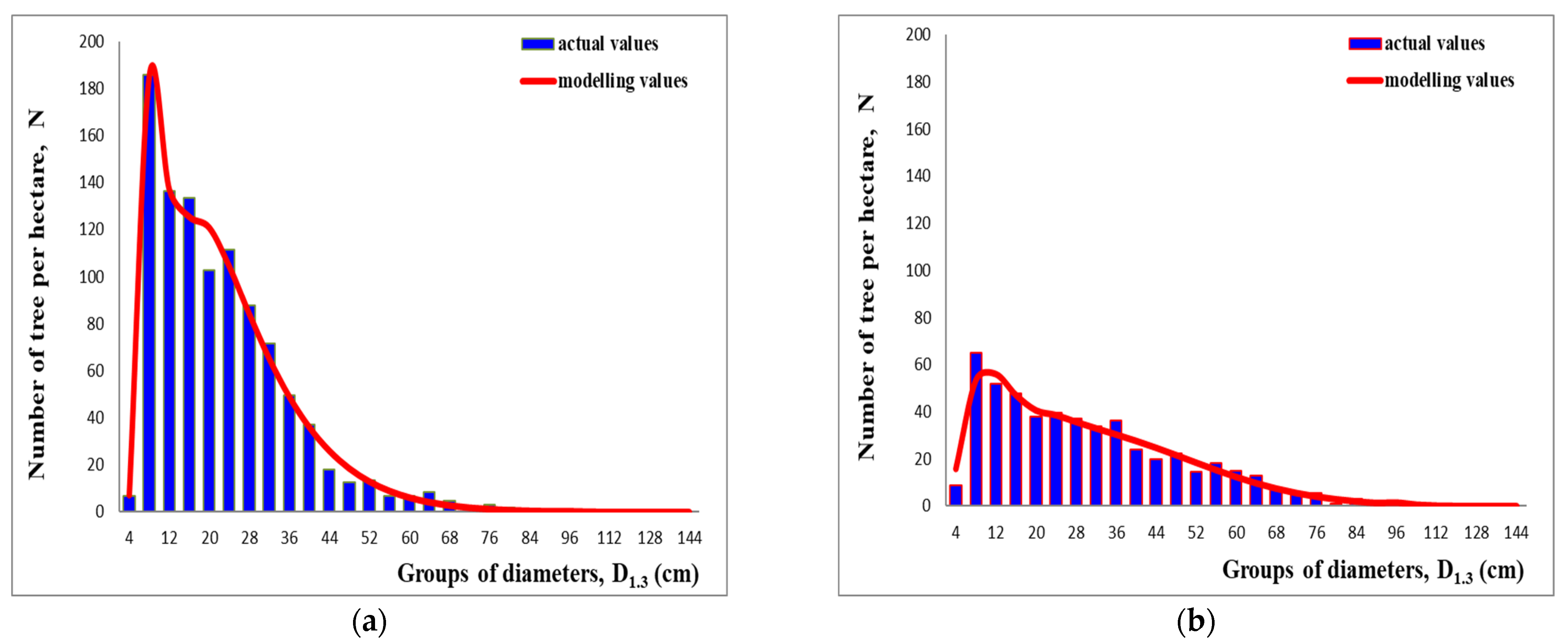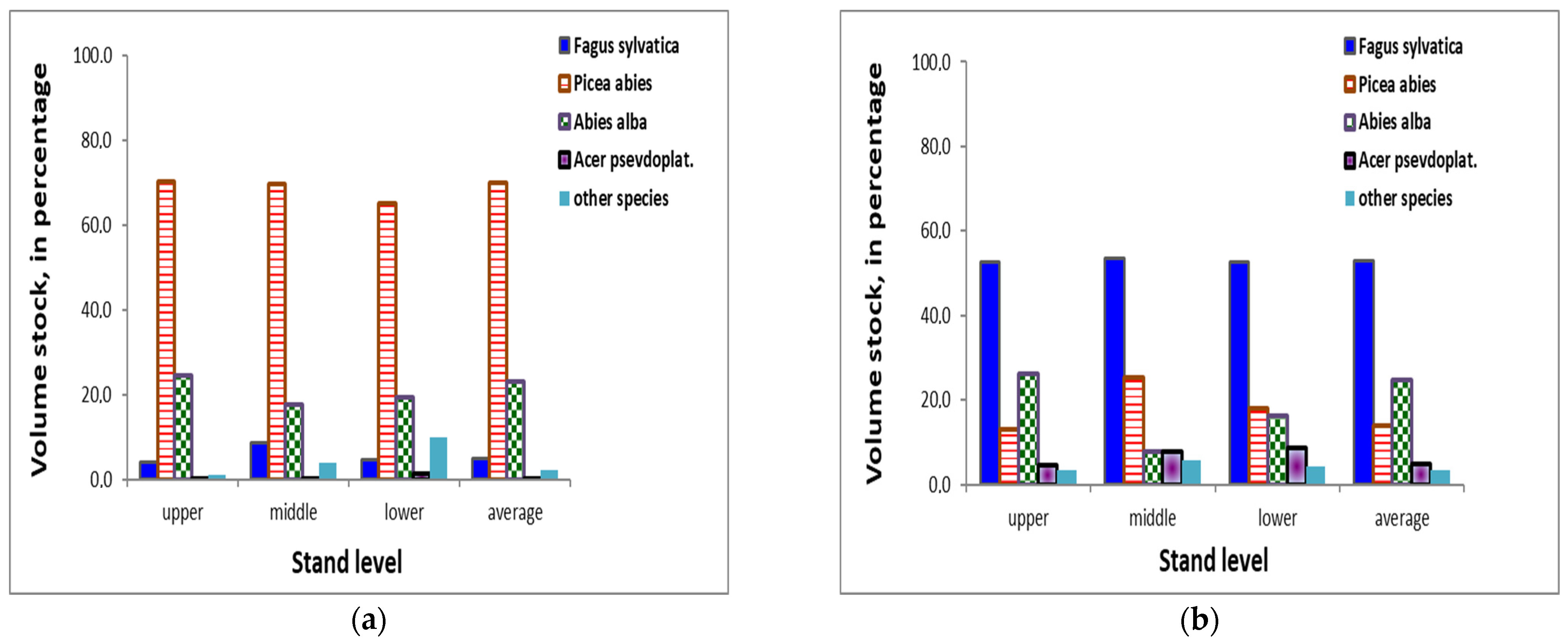Spatial Structure, Biodiversity Indicators and Carbon Stocks of the Old-Growth Natural Forests in the Protected Areas of the Ukrainian Carpathians †
Abstract
1. Introduction
2. Materials and Methods
2.1. Study Location
2.2. Use of Remote Sensing Data
2.3. Estimation of Forest Parameters
3. Results and Discussion
3.1. Diameter and Height Distributions
3.2. Vertical Structure
3.3. Horizontal Structure
3.4. Phytomass
4. Conclusions
Author Contributions
Funding
Informed Consent Statement
Data Availability Statement
Conflicts of Interest
References
- Stojko, S.M. Characteristic of primeval forests of Ukrainian Carpathian and their importance for the formation of close-to-nature sylviculture. In Natural Forests of Temperate Climate of Europe—Value and Usage, Proceedings of the International Conference 13–17 October 2003; Federal Research Institute WSL: Birmensdorf, Switzerland; Carpathian Biosphere Reserve: Rakhiv, Ukraine, 2003. (In Ukrainian) [Google Scholar]
- Smaliychuk, A.; Gräbener, U. Natural Forests of Ukrainian Carpathians; Carty i Atlasy: Lviv, Ukraine, 2008; p. 104. (In Ukrainian) [Google Scholar]
- Ancient and Primeval Beech Forests of the Carpathians and Other Regions of Europe. Available online: http://cbr.nature.org.ua/whc/whc.htm (accessed on 2 September 2022).
- Myklush, S.I.; Havryliuk, S.A. Informational content of the channels of satellite images Landsat 7 ETM+ for the vegetation interpretation. Sci. Bull. UNFU 2006, 16, 8–13. (In Ukrainian) [Google Scholar]
- Kashkin, V.B.; Suhinin, A.I. Remote Sensing from the Space; Logos: Moscow, Russia, 2001; p. 264. (In Russian) [Google Scholar]
- Lakida, P.I. Phytomass of the Forests of Ukraine: Monograph; Zbrutch: Ternopil, Ukraine, 2002; p. 256. (In Ukrainian) [Google Scholar]
- Lakida, P.; Nilsson, S.; Shvidenko, A. Estimation of forest phytomass for selected countries of the former European U.S.S.R. Biomass Bioenergy 1996, 11, 371–382. [Google Scholar] [CrossRef]
- Standard of Estimation of Aboveground Phytomass of the Trees of the Main Species in Ukraine: Reference Book; ECO-Inform: Korsun-Shevchenkivskyy, Ukraine, 2011; p. 192. (In Ukrainian)
- Tokar, O.Y.; Korol, M.M.; Shpakivska, I.M.; Dychkevich, V.M. Estimation of carbon stock in phytomass of forests using the information technologies. Sci. Bull. UNFU 2014, 24, 351–358. (In Ukrainian) [Google Scholar]
- Tokar, O.; Lesiv, M.; Korol, M. Information technology for studying carbon sink in stemwood of forest ecosystems. Econtechmod 2014, 1, 113–120. [Google Scholar]
- Tokar, O.; Gusti, M.; Vovk, O.; Havryliuk, S.; Korol, M.; Tobilevych, H. Geoinformation technology for the determination of carbon stocks in the dead organic matter of forest ecosystems in the Ukrainian Carpathians. Advances in Intelligent Systems and Computing IV. CCSIT 2019. In Advances in Intelligent Systems and Computing; Springer: Cham, Switzerland, 2020; Volume 1080, pp. 792–803. [Google Scholar]
- Pretzsch, H. Modellierung des Waldwachstums; Parey Buchverlag: Berlin, Germany, 2001; p. 341. (In German) [Google Scholar]
- Gadow, K.V. Waldstruktur und Wachstum: Beilage zur Vorlesung im Wintersemester 2003/2004; Georg-August-Universität Göttingen: Göttingen, Germany, 2003; 256p. (In German) [Google Scholar]
- Pukkala, T.; Gadow, K.V. Continuous Cover Forestry. In Managing Forest Ecosystems; Springer: Dordrecht, The Netherlands, 2012; Volume 23. [Google Scholar] [CrossRef]



| Index | Formula | Significance |
|---|---|---|
| Shannon index, EH | , , | EH = 0.00—absent; 0.25—low; 0.50—middle; 0.75—high; 1.00—very high |
| Tree differentiation index, Ti | , | Ti = 0.05—very low; 0.06–0.15—low; 0.15–0.30—middle; 0.31–0.60—high; more than 0.61—very high |
| Index | Formula | Significance |
|---|---|---|
| Clark-Evans, R | if R < 1—the disposition is group; R > 1—uniform disposition, R = 1—random disposition | |
| Donelli, RD | if R < 1—the disposition is group; R > 1—uniform disposition; R = 1—random disposition | |
| Angle index of Gadow, W | Wi = 0.00—strictly uniform; 0.25—uniform disposition; 0.50—group disposition; 1.00—random disposition |
| Name | Average dr, cm | Variation Indexes | Skewness, A | Kurtosis, E | Mode, Mo | Median, Me | ||||
|---|---|---|---|---|---|---|---|---|---|---|
| Minimal Value | Maximal Value | Variability, σ2 | Standard Deviation, σ | Coefficient of Variation, V | ||||||
| by diameter | ||||||||||
| NR “Gorgany” | 22.3 | 6.0 | 104.4 | 186.4 | 13.7 | 61.2 | 1.42 | 2.93 | 9.2 | 19.6 |
| NNP “Skole Beskids” | 30.0 | 6.0 | 105.0 | 354.8 | 18.9 | 62.8 | 0.77 | −0.08 | 9.3 | 26.5 |
| by height | ||||||||||
| NR “Gorgany” | 10.8 | 4.3 | 39.2 | 18.5 | 4.3 | 40.0 | 0.42 | −0.69 | 9.3 | 10.2 |
| NNP “Skole Beskids” | 19.0 | 4.2 | 41.8 | 102.2 | 10.1 | 53.2 | 0.22 | −1.1 | 9.9 | 18.0 |
| Name | Indexes of Horizontal Structure | Indexes of Species Diversity and Differentiation | ||||
|---|---|---|---|---|---|---|
| Clark-Evans, R | Donelli, RD | Angle Index of Gadow, W | Shannon Index, EH | Tree Differentiation Index, Ti | ||
| Diameter | Height | |||||
| NR “Gorgany” | 1.06 | 1.05 | 0.87 | 0.44 | 0.61 | 0.40 |
| NNP “Skole Beskids” | 1.07 | 0.98 | 0.78 | 0.63 | 0.63 | 0.53 |
Publisher’s Note: MDPI stays neutral with regard to jurisdictional claims in published maps and institutional affiliations. |
© 2022 by the authors. Licensee MDPI, Basel, Switzerland. This article is an open access article distributed under the terms and conditions of the Creative Commons Attribution (CC BY) license (https://creativecommons.org/licenses/by/4.0/).
Share and Cite
Korol, M.; Havryliuk, S.; Tokar, O.; Gusti, M. Spatial Structure, Biodiversity Indicators and Carbon Stocks of the Old-Growth Natural Forests in the Protected Areas of the Ukrainian Carpathians. Environ. Sci. Proc. 2022, 13, 27. https://doi.org/10.3390/IECF2021-10803
Korol M, Havryliuk S, Tokar O, Gusti M. Spatial Structure, Biodiversity Indicators and Carbon Stocks of the Old-Growth Natural Forests in the Protected Areas of the Ukrainian Carpathians. Environmental Sciences Proceedings. 2022; 13(1):27. https://doi.org/10.3390/IECF2021-10803
Chicago/Turabian StyleKorol, Mykola, Serhii Havryliuk, Olha Tokar, and Mykola Gusti. 2022. "Spatial Structure, Biodiversity Indicators and Carbon Stocks of the Old-Growth Natural Forests in the Protected Areas of the Ukrainian Carpathians" Environmental Sciences Proceedings 13, no. 1: 27. https://doi.org/10.3390/IECF2021-10803
APA StyleKorol, M., Havryliuk, S., Tokar, O., & Gusti, M. (2022). Spatial Structure, Biodiversity Indicators and Carbon Stocks of the Old-Growth Natural Forests in the Protected Areas of the Ukrainian Carpathians. Environmental Sciences Proceedings, 13(1), 27. https://doi.org/10.3390/IECF2021-10803






